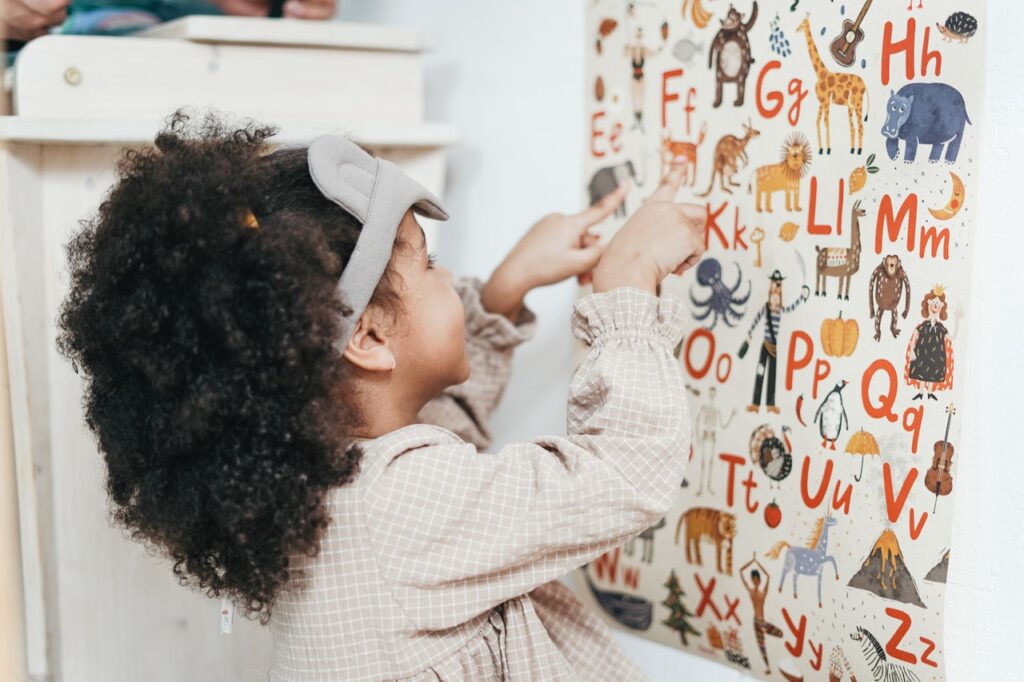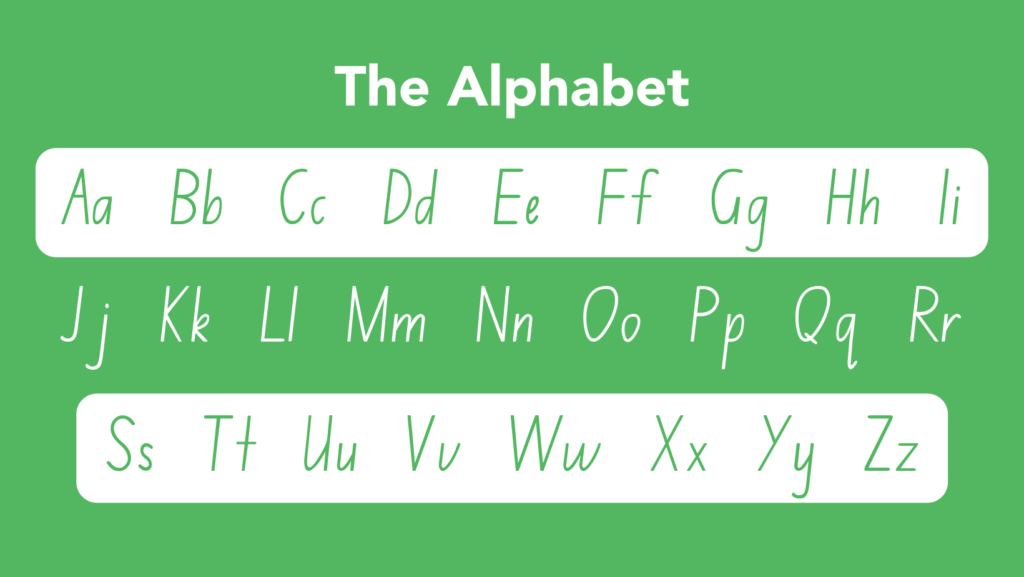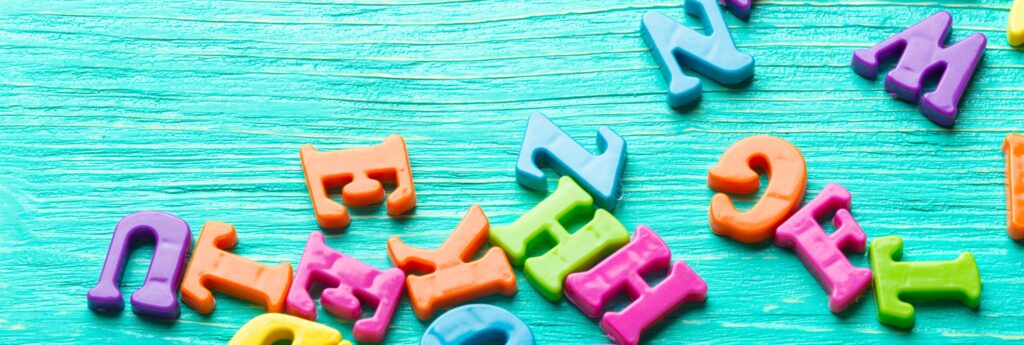When your child is first learning to read or become familiar with letters, alphabet learning can be hard — however, it’s important!
Memorising the alphabet at an early age is useful for learning about spelling, phonetics and pronunciation. It also helps children to think properly in a language.
If you’re concerned about this, don’t worry! We’ll break down three simple strategies for teaching your child the alphabet, examine why learning the alphabet is necessary and explain how to teach it well.
Keep reading to learn more!
Why teach the alphabet?
What are the important parts of learning the alphabet?
Tip #1: Associate Words With Letters
Tip #2: Teach Your Child to Write the Alphabet
Tip #3: Using Online Games and Face to Face Support
Why teach the alphabet?
As we just touched on, ensuring your child knows the alphabet is helpful for a variety of reasons.
Learning the alphabet is not simply a fun skill for kids to have tucked away. It can help with pronunciation and understanding of words, as children learn each letter phonetically.
It also helps children to think more fluently in their mother language, forming increasingly complex ideas. The most obvious advantages are that it helps with spelling and word formation.
Children who have a good understanding of the alphabet, and later how certain letters fit together, are more likely to connect words and understand common conventions.
What are the important parts of teaching the alphabet?
Teaching your child alphabet songs and the like is great, but there’s a little more to learning letters effectively.
Learning the ‘hard alphabet’ (e.g. a as “ay”, b as “bee”) is helpful for ordering letters and familiarisation, but it doesn’t necessarily help with spelling or understanding how letters fit together to form words.
The ‘soft alphabet’ or phonetic alphabet (e.g. a as “ah”, b as “buh”, c as “cuh”) is important, as it teaches children the way letters are usually pronounced. This is the alphabet we will be focussing most on today.
As your child progresses, it’s also great to start teaching how letters connect to form basic sounds or words. Having a background in the phonetic alphabet will really help with this.
Okay, with the explanation out of the way, let’s jump into practical strategies!
Tip #1: Associate words with letters
One of the best ways to teach children the phonetic alphabet and have them understand how letters fit into broader sounds is through basic word association. It’s important to select words that give a good example of the letter use (you wouldn’t pick the word gnome for ‘g’, for instance).
Picture Diagrams
Word associations are great, but if your child is learning the alphabet they likely can’t read yet. How do you then get them to remember what they have been taught?
Alphabet picture flashcards are great! They help young children to recognise a letter, associate it with an image and then reflect on the word for that image.
If you’re using flashcards, the key is to practise routinely. You might simply hold up the cards and go through letters each day. If you’d like to gamify the experience, here are some things you can do:
Play Memory
Print two sets of cards and play a classic game of memory match. This will help children to associate various elements (the picture, the sound, etc.) with each letter.
You can make this incredibly simple by having two matching cards, or you can mix it up a bit! Print a letter and then a corresponding image on the other card (eg. an ‘m’ on one card and a moon on the other), or even match letters that rhyme!
The One That Doesn’t Belong
Place several images all starting with the same letter and then choose another image that starts with a different letter. Have your child find which one is the right match!
Songs or Chants
Another great way to associate letters with certain words or sounds is by developing a chant for your child’s word associations. Most kids will remember “ants on the apple a a a” from primary school. It’s a testament to the fact that simple chants work!
These alliterative chants using word associations are effective for a few reasons. First, they encourage rote memory. They also help children to practise listening for letters when used in conjunction with other sounds.
Videos like this one may help teach such chants! You can also make them up according to things in your child’s life. Perhaps base them off family members (e.g. “sister is six, s s s”).
Tip #2: Teach your child to write the alphabet
Verbal and audible understanding of letters is just one part of teaching the alphabet. Children also need to be able to write the letters in a way they understand and that is legible.
Letter writing helps to establish how the alphabet fits together visually. It also makes the spoken word make sense to children on paper, which is a big part of learning to read.
However, it’s also important that this isn’t taught too early. There are four components to learning the alphabet:
- Letter recognition
- Letter naming
- Letter sound knowledge
- Letter writing
Trying to teach letter writing before the other steps have been ticked off can cause confusion. Further, many children in pre-school do not have the fine motor skills to write letters well.
Once your child is ready, there are several ways that you can teach them to write the alphabet!
Rainbow Alphabet
The rainbow alphabet technique has been endorsed by many teachers. It’s effective as it allows children to practise writing letters many times while developing their fine motor skills.
To complete this, grab a large piece of paper and write a letter in black marker. Then, encourage your child to pick different colours and trace the letter.
Eventually they can try writing it completely on their own! It’s also a good idea to put a green dot on the letter for where your child should start and a red dot for where they should finish. This will help them learn correct directionality when writing.
Magnetic Letters
If you think your child could benefit from learning to write or spell the alphabet but they don’t yet have the fine motor skills required, magnetic letters are a great start.
These letters allow your child to associate the form of specific letters with sounds. They can also learn to spell basic words, or even their name!
Tip #3: Using Online Games and Face to Face Support
Online games can be a fun way to help your child learn the alphabet — you can find free online alphabet games here. Just remember to assess each game and see what would work best for your child.
Finally, you may like to find some in person support! You can get in touch with great tutors at Art of Smart and we have a variety of resources to help you out, such as:
- Year 1 Spelling Words Worksheets
- Year 1 Recommended Reading List
- Making Maths Fun For Your Child — The Ultimate Guide
- 3 Simple Strategies to Help Improve Your Child’s Reading Comprehension
- Methods to Improving Your Child’s Vocabulary
There you have it!
From this article, you should feel more comfortable and equipped to teach your child the alphabet. Don’t be afraid to try various techniques or talk to other teachers and parents to find what has worked for them.
Looking for the next step? Take a peek at our FREE Year 1 Reading Comprehension Worksheets to see what’s coming!
Happy learning!
Looking for some extra help for your child with learning the alphabet?
We have an incredible team of tutors and mentors who can assist with implementing vocabulary improvement strategies!
We offer tutoring and mentoring for students in Years K-12 in a variety of subjects, with personalised lessons conducted one-on-one in your home or at our state of the art campus in Hornsby or the Hills!
We’ve supported over 8,000 students over the last 11 years, and on average our students score mark improvements of over 20%!
To find out more and get started with an inspirational tutor and mentor, get in touch today or give us a ring on 1300 267 888!
Lucinda Garbutt-Young hopes to one day be writing for a big-shot newspaper… or maybe just for a friendly magazine in the arts sector. Right now, she is enjoying studying a Bachelor of Public Communication (Public Relations and Journalism) at UTS while she writes on the side. She also loves making coffees for people in her job as a barista, and loves nothing more than a sun shower.






